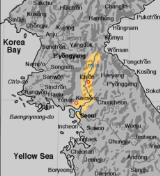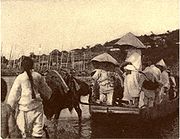
Imjin River
Encyclopedia
The Imjin River is a river of North
and South Korea
. It flows from North to South, crossing the Demilitarized Zone
and joining the Han River
downstream of Seoul
, very near the Yellow Sea
.
Seven-Year War in 1592, and the Battle of the Imjin River
that took place during the Korean War
.
 The active channel of the Imjin River utilizes only about 150 to 200 feet of the 1200 feet (365.8 m) width of the dry riverbed that it runs through, which is bordered by almost vertical rock cliffs standing approximately 75 feet (23 m) above the mean low water level. It gives no indication in normal times of the tremendous power it develops when in flood. During the Korean rainy season of July and August, the Imjin becomes a raging torrent, largely confined by its steep rocky banks. Fed by its larger tributaries and many small mountain streams, it reaches flood heights of 48 feet (15 m) above mean water level and a velocity of 15 to 20 feet per second (6 m/s). The rapid runoff of approximately 95 percent of precipitation during heavy general rains has caused the Imjin, on occasion, to rise at a rate of more than six feet per hour.
The active channel of the Imjin River utilizes only about 150 to 200 feet of the 1200 feet (365.8 m) width of the dry riverbed that it runs through, which is bordered by almost vertical rock cliffs standing approximately 75 feet (23 m) above the mean low water level. It gives no indication in normal times of the tremendous power it develops when in flood. During the Korean rainy season of July and August, the Imjin becomes a raging torrent, largely confined by its steep rocky banks. Fed by its larger tributaries and many small mountain streams, it reaches flood heights of 48 feet (15 m) above mean water level and a velocity of 15 to 20 feet per second (6 m/s). The rapid runoff of approximately 95 percent of precipitation during heavy general rains has caused the Imjin, on occasion, to rise at a rate of more than six feet per hour.
During the severe Korean winter, icy winds sweep down the Imjin; the sub-zero temperatures cause thick ice to form on the river. Fluctuations in the level of the river, particularly tidal action in the lower reaches, break up this ice, and large amounts of floe ice pile up against any obstacle in the channel.
The Imjin has been nicknamed by many in South Korea as the "River of the Dead" due to large numbers of dead bodies that have, in the past, floated down it from the North. The most recent occurrence was during the major famine of the 1990s when millions of North Koreans are believed to have starved to death for lack of sustenance.
North Korea
The Democratic People’s Republic of Korea , , is a country in East Asia, occupying the northern half of the Korean Peninsula. Its capital and largest city is Pyongyang. The Korean Demilitarized Zone serves as the buffer zone between North Korea and South Korea...
and South Korea
South Korea
The Republic of Korea , , is a sovereign state in East Asia, located on the southern portion of the Korean Peninsula. It is neighbored by the People's Republic of China to the west, Japan to the east, North Korea to the north, and the East China Sea and Republic of China to the south...
. It flows from North to South, crossing the Demilitarized Zone
Korean Demilitarized Zone
The Korean Demilitarized Zone is a strip of land running across the Korean Peninsula that serves as a buffer zone between North and South Korea. The DMZ cuts the Korean Peninsula roughly in half, crossing the 38th parallel on an angle, with the west end of the DMZ lying south of the parallel and...
and joining the Han River
Han River (Korea)
The Han River is a major river in South Korea and the fourth longest river on the Korean peninsula after the Amnok, Duman, and Nakdong rivers. It is formed by the confluence of the Namhan River , which originates in Mount Daedeok, and the Bukhan River , which originates on the slopes of Mount...
downstream of Seoul
Seoul
Seoul , officially the Seoul Special City, is the capital and largest metropolis of South Korea. A megacity with a population of over 10 million, it is the largest city proper in the OECD developed world...
, very near the Yellow Sea
Yellow Sea
The Yellow Sea is the name given to the northern part of the East China Sea, which is a marginal sea of the Pacific Ocean. It is located between mainland China and the Korean Peninsula. Its name comes from the sand particles from Gobi Desert sand storms that turn the surface of the water golden...
.
History
The Imjin River was the site of two major battles: The Battle of the Imjin River during theSeven-Year War in 1592, and the Battle of the Imjin River
Battle of the Imjin River
The Battle of the Imjin River, also known as the Battle of Kumgul-san, P'ap'yong-san and Solma-ri or the Battle of Xuemali , took place 22–25 April 1951 during the Korean War. Forces from People’s Republic of China attacked UN positions on the lower Imjin River in an attempt to achieve a...
that took place during the Korean War
Korean War
The Korean War was a conventional war between South Korea, supported by the United Nations, and North Korea, supported by the People's Republic of China , with military material aid from the Soviet Union...
.
Characteristics

During the severe Korean winter, icy winds sweep down the Imjin; the sub-zero temperatures cause thick ice to form on the river. Fluctuations in the level of the river, particularly tidal action in the lower reaches, break up this ice, and large amounts of floe ice pile up against any obstacle in the channel.
The Imjin has been nicknamed by many in South Korea as the "River of the Dead" due to large numbers of dead bodies that have, in the past, floated down it from the North. The most recent occurrence was during the major famine of the 1990s when millions of North Koreans are believed to have starved to death for lack of sustenance.
External links
- http://www.imjinscout.com/BTI_Chapter1.html

